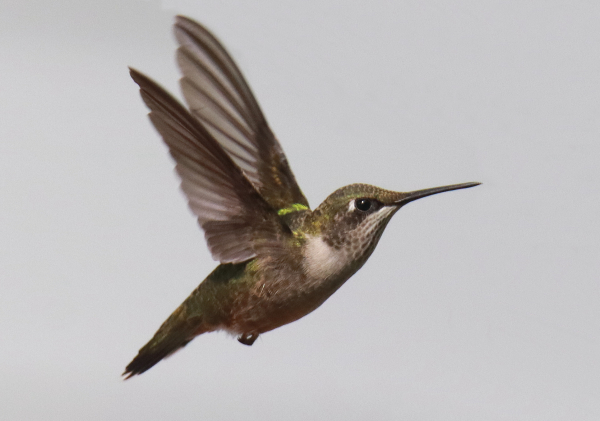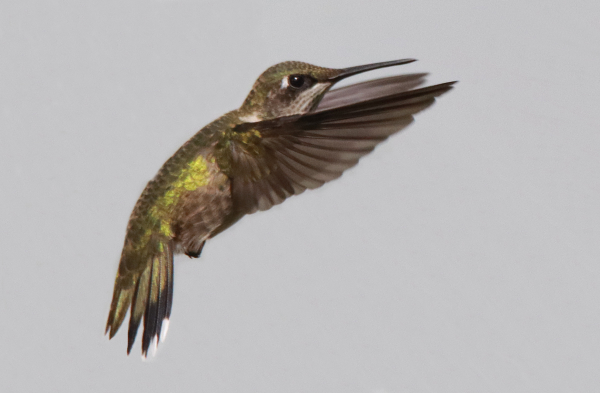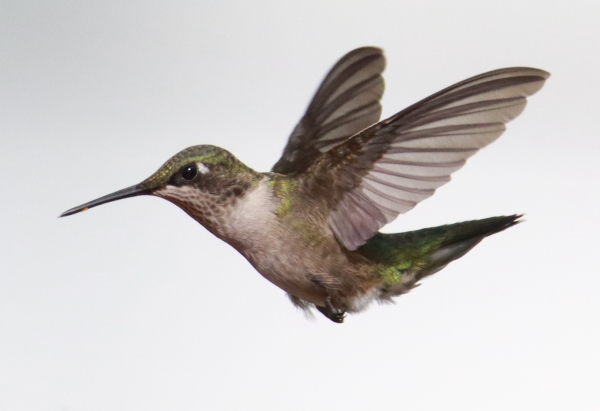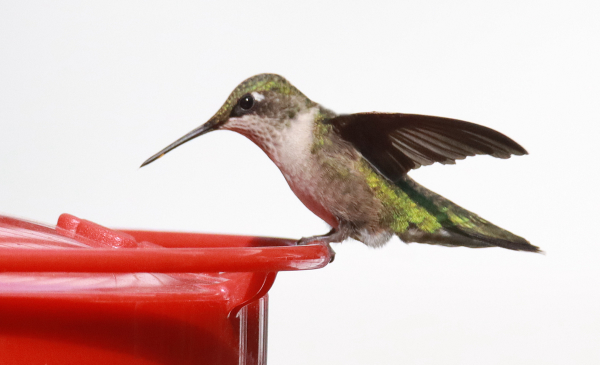We all enjoy seeing hummingbirds, and most often we see the hummingbirds that visit the nectar feeders in our yards. I’ve been reporting on the hummingbirds that visit my feeder during recent weeks in the Editor Afield article, and included a photo of a Ruby-throated Hummingbird to illustrate 2 of those articles. But although it wasn’t too obvious in the photos shared in the half-page format of the Editor articles, the quality of the images was compromised. That’s because I took the photographs from inside my house through a window, which distorts the quality of my camera lens a bit and reduces the sharpness of the resulting photos.

There is a simple fix, but I’ve been hesitant to get serious about photographing hummingbirds this season, and although I hate to admit it, it’s been due to the activities of even smaller and much more abundant animals – mosquitos. During recent years I have developed an acute reaction to mosquito bites, and mosquitos have been exceptionally abundant and tenacious during late summer, so it’s been hard to put myself in harm’s way in my yard. West Nile Virus has also been a concern other years when neighbors were affected. That said, I had some good luck photographing hummingbirds through a window last week and edited a few of them with the plan to share them with you all.
But more important, having a little success through the window under backlighting conditions activated me to get outside with my camera to 1) stand at a position where the sun was at my back, 2) where the nectar feeder was in focus, 3) where the background was a uniform white-gray (the color of my house, which I used as a background), 4) all during the optimum time for me to have the best full sunlight – between noon and 1:10. Simple enough, aside from the almost constant mosquito attacks. A half-hour was all the time I could stand among the buzzing, biting bugs, but that was really longer than I needed to get some excellent photographs. Plus, on Saturday, when I took the photographs that illustrate this article, I had less than 15 minutes of sunlight during the noontime photo period.

Perhaps that just goes to show that you don’t need a lot of time or devotion to photograph hummingbirds at a pretty high quality level – with a little luck. But in addition to the sunlight parameters, there are the technical settings of your camera that come into play. First, I plead with you to never use an automatic setting when photographing birds. I always use and recommend using the AP (Aperture Priority) setting that allows me to select the aperture, with the camera providing the corresponding shutter speed. In my case, I wanted the fastest shutter speed possible to try to stop the action of a flying hummingbird, that with the corresponding aperture that would blur the background into a fairly uniform color.
With that in mind, I started using an f-6 aperture setting, which provided a uniformly blurred background color with the fastest possible shutter speed at my usual 800 ISO setting. However, during my second photo session I decided it would be helpful to have a little wider area in focus when the hummingbirds were in flight, so changed the aperture slightly to f-7, but that did the trick. At the same time, I wanted a faster shutter speed, so increased the ISO to 1600 and those changes improved my photos just as I hoped.

Ready for the action, I did my best to pre-focus on the nectar feeder and wait for a hummingbird to approach. In some cases, the hummingbird would hesitate a moment before landing on the feeder’s circular perch, hovering in place a second or 3 before landing. After feeding on the sugar-water mixture, a hummingbird might reposition to a different feeding port, possibly hovering a moment or 2 – and during the exceptionally brief moments I would try to focus and photograph the birds. During the most productive photo period, a second hummingbird flew close, precipitating the feeding bird to fly above the feeder a couple moments, providing 2 of my best photos of a hummer in flight. Of course, I also photographed the birds when they were feeding in a perched position.
Then it was on to the review process, checking for the best photos, then cropping them to suit this publication’s full-page and half-page photo options (full-page or half-page here in the feature article; but only half-page in the other articles). You can see a number of half-page photographs I took of the hummingbirds in the Backyard Birding article in this issue (and you can get a few more photo tips there too). While photographing at my feeder, I also had a couple opportunities to photograph a hummingbird as it perched in my nearby elm tree with green leaves in the background, with dark bark in the background, and with a blue sky background. Some of the green background photographs are included in Backyard Birding that show more iridescent highlights in the plumage of a hummingbird.

With such rewarding photographs produced in such a short amount of time (less than 45 minutes total over 2 photo periods) you can bet I’ll be photographing any sunny noontime as long as the hummingbirds continue to visit my nectar feeder. And I’m hoping my descriptions and information will give you the incentive to try this simple hummingbird photo strategy yourself. At the same time, you can use this same simple technique when other birds visit your seed and suet feeders, as well as your birdbath. Enjoy your yard birds and try photographing them when you can, even when mosquitos are a factor.
Article and Photographs by Paul Konrad
Share your bird photos and birding experiences at editorstbw2@gmail.com